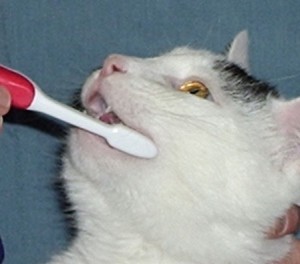Brushing your cat’s teeth is the main component of home care. The purpose  of this is to remove plaque before it becomes tartar. Plaque is the coating on the teeth that includes bacteria, saliva and food particles that adheres to the teeth and the pocket of space between the tooth and the gum. Left in place, plaque rapidly collects minerals from the saliva to form the rock-like brown deposits known as tartar or calculus. By brushing daily, you remove the plaque so the tartar builds up more slowly. As with all things, the better you and your cat are at brushing daily, the better results you will get.
of this is to remove plaque before it becomes tartar. Plaque is the coating on the teeth that includes bacteria, saliva and food particles that adheres to the teeth and the pocket of space between the tooth and the gum. Left in place, plaque rapidly collects minerals from the saliva to form the rock-like brown deposits known as tartar or calculus. By brushing daily, you remove the plaque so the tartar builds up more slowly. As with all things, the better you and your cat are at brushing daily, the better results you will get.
EXAMINING THE TEETH
The first step is to have your veterinarian perform a physical examination. This includes an oral exam to determine what level of dental disease is present. You certainly would not want to start brushing your cat’s teeth if he or she has a painful mouth as that would be a very unpleasant experience for him or her. At this point if dental work is needed, that should be the next thing to be scheduled.
ANESTHESIA
To perform a complete dental cleaning your kitty will need to be under anesthesia. Anesthesia monitoring for a cat is now like it is for you and me. Your cat will have an IV ( intravenous) catheter with fluids to help maintain blood pressure, blood pressure monitors, oxygen, breathing, and heart rate monitors and of course a technician to monitor as well.
PROFESSIONAL CLEANING
A dental cleaning involves a thorough cleaning both above and below the gum line with an ultrasonic scaler and other specialized equipment exactly like your dentist and hygienist use on you. Dental radiographs (x-rays) are also taken to look for damaged and diseased teeth. If there are diseased teeth, a decision will be made as to which can be saved by more extensive work or if they have to be removed. At the end of all procedures, the teeth are polished to smooth rough surfaces. In the cat, as in humans and other animals, genetic factors influence how well their immune system controls the bacteria that cause periodontal disease. Some cats have great resistance and do fine with professional cleanings annually, others may need to have cleanings twice a year. Of course, their diet, overall health and how much home care you provide also play a role here.
HOME CARE
Now that the teeth are clean and healthy, it’s up to you to convince your cat that daily tooth brushing is an enjoyable activity! Of, course if your kitty had teeth removed or is still sore from other dental procedures, don’t start brushing until your veterinarian says it’s o.k. to start. The guidelines below are not hard and fast rules. Each animal is different. If you are starting with your 8 week old kitten this may go fast and be very easy. An older cat, especially one that may have had a sore mouth for a long time, may take weeks of training to get comfortable. Go at your cat’s pace and be patient. Keep your training sessions short and frequent rather than one long one.
1) Start by choosing a place like a counter top, that you will use consistently for this activity. Try to always do this about the same time of day. Make sure there are yummy treats nearby. Then begin working with and around your cat’s mouth. Use your finger to gently rub the chin, the lips, and the muzzle. Then give a small treat. Lift the lips a bit with your finger. Give a treat. As soon as he or she is comfortable with this step move onto step 2.
2) Begin to gently slip your finger in to rub the outside of the teeth for short periods of time before returning to just rubbing the lips, chin, etc. Slowly lengthen the time you are rubbing the teeth. Don’t forget to give treats!
3) Now it’s time to introduce some toothpaste (as recommended by your veterinarian, do NOT use human toothpaste or baking soda) onto your finger while doing the rubbing. If this is going well you can wrap some gauze around your finger to provide a rough surface to rub the toothpaste on the teeth.
4) If possible, it’s now time to try a toothbrush with the toothpaste. There are a variety of cat-sized toothbrushes available. Gently brushing from the gum line down with the toothbrush slightly angled (45 degrees) is best. Some people find gauze on their finger works best. Others are able to move onto a toothbrush. Whichever you find your cat accepts is the best to use.
5) Remember to go slowly, at a pace the cat accepts and to use treats to reward your cat for sitting for this activity.
6) Your veterinarian may also recommend special dental diets to be used as treats or a primary diet depending on your individual cat’s health issues. There are also specialized treats, like C.E.T. chews, that if given daily will help reduce plaque build-up. Medicated mouth rinses are also sometimes used in cats that have periodontal disease to further reduce bacterial build-up.
7) To see this in real life, log onto the internet and go to:
http://www.felinevideos.vet.cornell.edu/pet-owners/cat-teeth/entire-video
If you would like to schedule an appointment for your cat click here : http://northernilcatcliniccom.web.siteprotect.net/schedule-appointment/